

Microservice authentication and authorisation. Below is a sequence diagram describing a common pattern for handling authentication and authorisation in a microservice solution, where you have a number of small web services interconnected and don’t want them all having to implement authentication and authorisation individually, just to be simple services focused on their job.
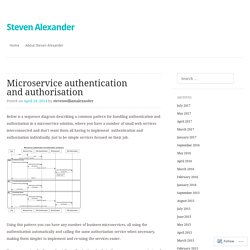
Using this pattern you can have any number of business microservices, all using the authentication automatically and calling the same authorisation service when necessary, making them simpler to implement and re-using the services easier. You can go a step further and put the authorisation checks in the reverse proxy against each service endpoint but this requires the reverse proxy to know the actions/permissions of each service, plus it’s likely your services permissions will be dynamic based on execution. Nginx with lua scripts are a good way of implementing the smart reverse proxy, below are some links about this. Like this: Like Loading... Token-based Active Directory Authentication Using OWIN. Authentication in a microservices architecture (.net) – Ole Petter Dahlmann.
When you want to decentralize your application with independently deployable services you would probably design your software applications in a Microservice Architecture style.

While there is no “best practice” or pattern to follow, you will most likely already have several projects running that would benefit from being smaller endpoints totally independent. Having a HTTP API application as a suite of small services will get you faster to market, give each developer in your team an ownership and do changes to small parts of your application fast.
In this post I will show you one approach for handling Authentication and Authorization for each small service. This is one of many ways, and I suppose the most common way is to have one or more endpoints as a gateway to all your small services and let that handle authentication. Series: Owin Authentication « Passion for Coding. Owin is the next hot thing that everyone (or at least those following the bleeding edge of .NET development) is talking about.
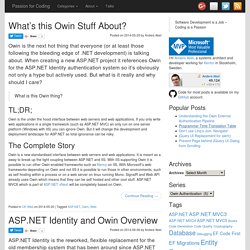
When creating a new ASP.NET project it references Owin for the ASP.NET Identity authentication system so it’s obviously not only a hype but actively used. But what is it really and why should I care? Adding minimal OWIN Identity Authentication to an Existing ASP.NET MVC Application - Rick Strahl's Web Log. As of ASP.NET 4, ASP.NET provides a fairly useful identity system.

If you create a new project and choose an MVC project and choose to add both internal and external authentication, it’s fairly straight forward to get a reasonable identity implementation into your application. However, if you have an existing application, or if the full Entity Framework based identity structure doesn’t work for you, then the process to hook up a minimal and custom implementation that uses your own domain/business model and classes is not exactly as straightforward. You have to either rip out the pieces you don’t need from an full template install, or add the necessary pieces. In this post I hope I can show you how to do the latter, showing only the pieces that you need. The process is not necessarily hard – but it’s not very well documented. Token-based Active Directory Authentication Using OWIN. ASP.NET Web Api: Understanding OWIN/Katana Authentication/Authorization Part I: Concepts.
Recently we looked at the fundamentals of the OWIN/Katana Middleware pipeline, and we then applied what we learned, and built out a minimal, OWIN-Based, self-hosted Web Api.
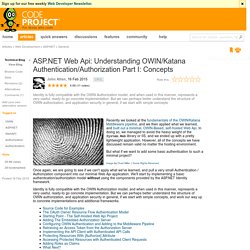
In doing so, we managed to avoid the heavy weight of the System.Web library or IIS, and we ended up with a pretty lightweight application. However, all of the concepts we have discussed remain valid no matter the hosting environment. C# ASP.NET Single Sign-On Implementation. Introducing Single Sign-on to an existing ASP.NET MVC application. Implementing a single sign-on for a set of a company's business applications isn't hard if they are all new applications, especially if you use WS-Federation and and Identity server such as Thinktecture.

If it is a mix of new and existing applications then it helps to sort out any problems if you first understand the technology as a whole, and appreciate how it works. Jarek shares his experiences. I’m currently working on a project that requires us to integrate an existing ASP.NET MVC application with a number of new systems, both back- and front-office. The user would like them all to work together as if it were one integrated application, and a key requirement is that there should be a single sign-on (SSO) for all the web systems. Users will need to be able to navigate between pages of any or all of these applications without the tiresome chore of repeated authentication. The diagram presents the basic steps of the SSO process for web applications using passive redirection mechanism. Introducing Single Sign-on to an existing ASP.NET MVC application. Making your ASP.NET Web API’s secure. Note: Code for this example is on Google Docs.

SecureWebAPISecureWebAPITest Recently, I’ve been exploring the new ASP.NET Web API. So far, I’ve been impressed with how easy it is to build RESTful web interfaces. In the examples I’ve published, none have been secure. In the real world – the world that exists beyond the world of samples and demos – security is a matter than cannot be brushed aside. In research this topic, looking what others have done this far, I came away with a lot of approaches that in my opinion, where too complicated and quite frankly, a pain to setup. For many applications, OpenID or oAuth can work fine. Of all the things that can be done to make your API, more secure, requiring it to run over HTTPS is the easiest thing to implement. Here is the custom action filter. IdentityServer3. How does SO's new auto-login feature work?
I'm going to provide more than just the technical details here, as I think there are alot of implicit assumptions about global login that aren't quite correct out there.
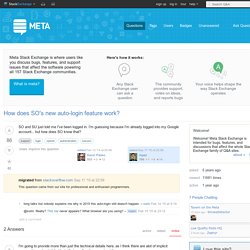
Accordingly, this is going to be really long. Design Requirements A user having logged into any SE-site will be automatically logged into every other SE-site on which they have an accountSite level logins must not fail if the global login system is downMust not present unexpected sites or information to the userMust not degrade the anonymous user experience 1 is obvious, 2 is due to a strong desire not to introduce a new network wide dependency, 3 is shorthand for "don't scare off the user," and 4 is an acknowledgement of how much of our traffic is from anonymous users.
These are taken as axiomatic, any scheme that didn't fulfill all 4 was immediately discarded. Global Network Auto-Login – Stack Overflow Blog – A destination for all things related to development at Stack Overflow. Global Network Auto-Login by Jeff Atwood on September 11, 2010 We now support automatically logging in to any site in the Stack Exchange network.
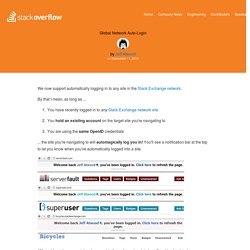
By that I mean, as long as ... You have recently logged in to any Stack Exchange network siteYou hold an existing account on the target site you're navigating toYou are using the same OpenID credentials ... the site you're navigating to will automagically log you in! (We just forced every registered account in the entire network to log off and log back in to ensure that everyone has logged in under this new regime -- so everyone should meet criteria #1 by definition.)
Deploying application and OWIN authorization server on separate machines. Scenario Say you’ve created a web application with the single page application template in Visual Studio 2013.
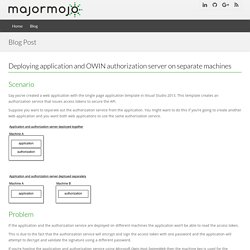
This template creates an authorization service that issues access tokens to secure the API. Relationship between IdentityServer and AuthorizationServer. We released a preview version of AuthorizationServer this week. AuthorizationServer is an implementation of the OAuth2 design pattern and helps making API authorization easier. IdentityServer also has OAuth2 endpoints – so you might ask yourself why we started from scratch with a new project and did not just add more features to the existing IdSrv endpoints. We were also discussing this quite a bit – here’s a summary of our thinking. Separation of authentication and authorization AS (as the name implies) is all about authorization (see my post).
GitHub - IdentityModel/AuthorizationServer: Sample implementation of an OAuth2 Authorization Server. IdentityServer/IdentityServer3. Implement custom Claim based Authorization in ASP.NET MVC Web Application. To download the source code please click here Introduction. C# - Redirecting unauthorized controller in ASP.NET MVC. OAuth2 Framework. 1. Overview The OAuth2 standard is still in the making so expect changes. Effective Forms Authentication, Part 1. By Mike Gunderloy 02/02/2004 ASP.NET offers several possibilities for authenticating users, but when you come right down to it, there's only one reasonable alternative for most applications: forms authentication. ASP.NET MVC 3 using Authentication. C# - Any tutorials on creating an MVC3 login system without the default ASP.Net membership providers.
Examining ASP.NET's Membership, Roles, and Profile - Part 1. By Scott Mitchell Introduction There's one thing messageboard websites, eCommerce websites, social network websites, and portal websites share in common: they all provide user accounts. These websites, and many others, allow (or require) visitors to create an account in order to utilize certain functionality. For example, a messageboard website, like ASPMessageboard.com, allows anonymous and authenticated visitors to view and search the posts in the various forums. ASP.Net MVC 3 Custom Membership Provider with Repository Injection. Custom Role Provider. Часть 1 « shiftnotes. ASP.Net MVC Membership Starter Kit alternative authentication. Last week, I blogged about the ASP.Net MVC Membership Starter Kit and some of its features. Custom MembershipProvider and RoleProvider Implementations that use Web Services.
Latest. ASP.NET MVC 2 Custom Membership Provider Tutorial – Part 3 « The Integrity. Continued from: ASP.NET MVC 2 Custom Membership Provider Tutorial – Part 2 In the previous part of the tutorial we implemented CreateUser method which successfully creates new user in the database. Custom ASP.NET MVC Authorization with Facebook Connect. Custom Authentication provider by implementing IHttpModule, IPrincipal and IIdentity. Introduction. Securing your ASP.NET MVC 3 Application - Ricka on MVC and related Web Technologies. Executive Overview.